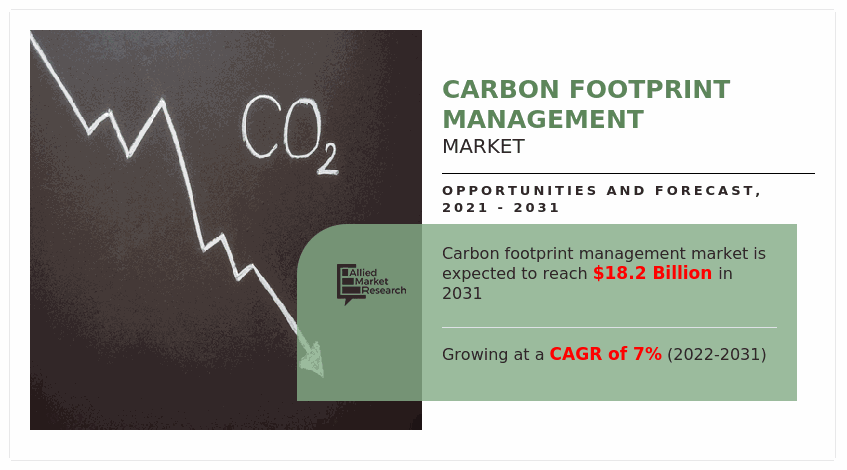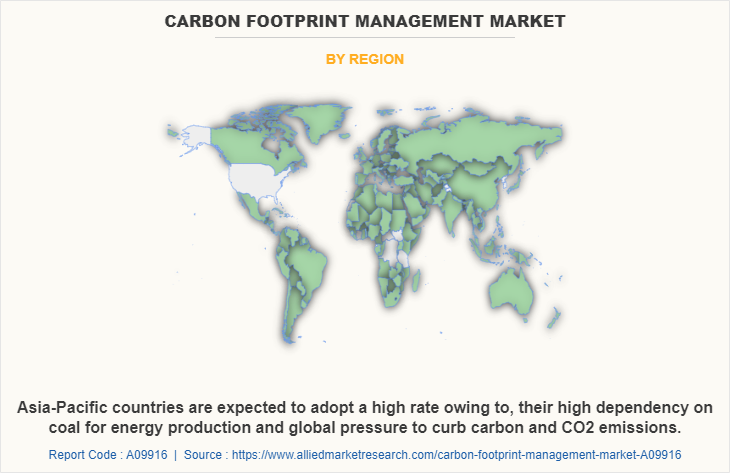Carbon Footprint Management Market Statistics, 2031
The global carbon footprint management market was valued at $9.3 billion in 2021, and is projected to reach $18.2 billion by 2031, growing at a CAGR of 7% from 2022 to 2031.
Increase in demand for energy consumption by industries and the drive for more sustainable energy solutions propel the global carbon footprint management market growth. Moreover, increase in government initiatives and policies for low carbon policies are positively impacting the growth of the carbon footprint management market. However, higher installation and maintenance costs of carbon footprint management can hamper the carbon footprint management solutions market during the forecast period.

On the contrary, the growing adoption trends of advanced technologies, such as artificial intelligence, IoT, and big data, across industries to reduce carbon emission is expected to offer remunerative opportunities for expansion of the carbon footprint management market during the forecast period. Based on industry vertical, the market is divided into energy and utilities, manufacturing, residential and commercial buildings, transportation and logistics, and IT and telecom.
Carbon footprint management systems can assist a business organization in calculating, tracking, reporting, and managing its carbon emissions (or a residential complex). Carbon footprint management systems are designed to guarantee that the facilities being monitored do not exceed the amount of emissions permissible by local and national regulations. However, if emissions surpass the safe level, the carbon footprint management solution can alert the proprietor, who can then take the appropriate actions. Such applications of CFM solutions enable its growth in the modern-day world. The carbon footprint management market size is segmented into By Component, By Deployment Mode and By Industry Vertical.
The carbon footprint management market is segmented on the basis of component, deployment mode, industry vertical, and region. On the basis of component, the market is divided into solution and service. Depending on deployment mode, the market is classified into on premise and cloud. By industry vertical, the market is segmented into energy and utilities, manufacturing, residential and commercial buildings, transportation and logistics, and IT and telecom. Region wise, it is analyzed across North America, Europe, Asia-Pacific, and LAMEA.
The global carbon footprint management market is dominated by key players such as Carbon Footprint Ltd, Dakota Software Corporation, ENGIE, IsoMetrix, IBM, ProcessMAP, General Electric, Salesforce, SAP, and Wolters Kluwer N.V. These players have adopted various strategies to increase their market penetration and strengthen their position in the industry.
By Industry Vertical
The Residential and Commercial Buildings segment is anticipated to grow at a significant rate owing to, the growing awareness regarding the negative effects of excess carbon production and the fear of climate change.
Depending on industry vertical, the energy and utilities segment dominated the carbon footprint management market share in 2020, and is expected to continue this trend during the forecast period owing to the growing demand for energy and resources across various industries and business sectors. However, the residential and commercial buildings segment is expected to witness the highest growth in the upcoming years, owing to various government and industry regulations to support green and sustainable economic activities.

Region-wise, the carbon footprint management industry was dominated by North America in 2020, and is expected to retain its position during the forecast period, owing to strong initiatives by the local government to minimize the effects of global warming. However, Asia-Pacific is expected to witness significant growth during the forecast period, owing to its rapid economic transformation and the rise in awareness regarding the increasing carbon emissions in the region, which is expected to fuel the growth of carbon footprint management solutions in the region in the coming few years.
The report focuses on growth prospects, restraints, and analysis of the global carbon footprint management market trend. The study provides Porter’s five forces analysis to understand the impact of various factors, such as bargaining power of suppliers, competitive intensity of competitors, threat of new entrants, threat of substitutes, and bargaining power of buyers on the global carbon footprint management market share.
Top Impacting Factors
Increase in Government Initiatives for Low Carbon Policies
Governments across the globe are seriously considering the consequences of rapid industrialization and the unbalanced production of carbon, as these unmoderated carbon emissions cause some serious health and environmental damage. A number of countries, regions, and local governments have already implemented a carbon tax or something similar, such as energy tax (based on the carbon emission during the production of the energy). According to an article published by the American environmental nonprofit organization, Center for Climate and Energy Solutions, in 2021, 35 carbon tax programs have already been implemented across the globe.
Moreover, many countries are implementing serious tax laws and regulations on their businesses and industrial areas to check their carbon footprint. For instance, in May 2019, South Africa became the first African country to implement a carbon tax. South Africa has proposed a tariff of $8.34 per tonne of carbon dioxide equivalent. Such policies promise great scope of opportunities for the future of carbon footprint management solutions in the coming years.
Increase in Demand for Energy Consumption by Industries
The energy requirement of the industrial sector is on the rise. For instance, according to an article published by the U.S. Energy Information Administration, the industrial sector of the U.S. was responsible for consuming more than 36% of its total energy consumption for 2020, out of which, more than 77% of the energy was utilized by the manufacturing sector businesses. Similarly, Statistics Canada in 2020 reported that the energy consumption of the manufacturing sector increased by over 6% since 2009. Such trends are showcasing growth in energy requirement by the industrial sector across the globe as energy production still depends on coal. According to the U.S. Energy Information Administration, the total energy production of the U.S. in 2020-2021 consisted of 22% of coal-powered energy sources. Such factors enable governments and industries to employ carbon footprint management solutions.
COVID-19 Impact Analysis
With COVID-19 cases on the rise globally, many businesses and organizations in the manufacturing and fabrication industries were forced to limit or even halt their operations entirely during COVID-19-related lockdowns. In addition, with limited availability of staff and workers on-site, organizations were facing difficulties to maintain full-scale productivity during the period. Because of these constraints, the carbon footprint management industry's applications were limited, and the market endured a slowdown during the pandemic.
However, rise in consumer awareness of personal carbon footprint management has resulted in a steady growth trend in several industrial and residential applications, allowing for its growth in relatively less explored business verticals. This has enabled many key players in the industry to launch specialized products to cater to a newer customer base. For instance, in August 2020, Carbon Footprint Ltd. announced the launch of its Carbon Calculator. Carbon Calculator is a carbon footprint calculator for individuals and households. Such instances are promising great opportunities for the growth of the carbon footprint management market in the coming years.
Key Benefits for Stakeholders
- The study provides an in-depth analysis of the global carbon footprint management market forecast along with current & future trends to explain the imminent investment pockets.
- Information about key drivers, restraints, & opportunities and their impact analysis on global carbon footprint management trends is provided in the report.
- Porter’s five forces analysis illustrates the potency of the buyers and suppliers operating in the industry.
- The quantitative analysis of the market from 2021 to 2031 is provided to determine the market potential.
Carbon Footprint Management Market Report Highlights
| Aspects | Details |
| By Component |
|
| By Deployment Mode |
|
| By Industry Vertical |
|
| By Region |
|
| Key Market Players | ENGIE, SAP, Dakota Software Corporation, Schneider Electric, ProcessMAP, Carbon Footprint Ltd, IsoMetrix, ibm corporation, Wolters Kluwer N.V. |
Analyst Review
Demand for carbon footprint management platforms has been on a rise for the past few years and the market is expected to continue this trend in the coming years as well, owing to growing trends towards green and sustainable technology, which promote the use of carbon footprint management solutions. Moreover, increase in advancements in AI and data analytics solutions prove to be beneficial for the development of carbon footprint management solutions in the coming years. In addition, the growing fear of climate change and global warming are promising new opportunities for the growth of the carbon footprint management market.
Key providers of the carbon footprint management market, such as IBM, General Electric, and SAP account for a significant share of the market. With larger requirements from carbon footprint management, various companies are establishing partnerships to increase carbon footprint management capabilities. For instance, in February 2022, IBM Corporation announced a partnership with WorleyParsons Limited and ABB Ltd. to help energy companies build and operate green hydrogen facilities more efficiently and at scale.
In addition, with the increase in demand for carbon footprint management, various companies are expanding their current product portfolio with increasing diversification among customers. For instance, in January 2021, SAP SE, a German multinational software corporation announced the launch of its SAP Product Footprint Management, a solution that lets companies calculate carbon footprints for their products and across the value chain. It considers the entire product lifecycle, helping companies disclose their products’ environmental footprints to regulators and enabling them to make their products more sustainable.
Moreover, market players are expanding their business operations and customers by increasing their acquisitions. For instance, in January 2022, IBM Corporation announced acquisition of Envizi, a leading data and analytics software provider for environmental performance management. This acquisition builds on IBM's growing investments in AI-powered software, including IBM Maximo asset management solutions, IBM Sterling supply chain solutions, and IBM Environmental Intelligence Suite, to help organizations create more resilient and sustainable operations and supply chains.
Increase in demand for energy consumption by industries and the drive for more sustainable energy solutions propel the growth of the global carbon footprint management market. Moreover, increase in government initiatives and policies for low carbon policies are positively impacting the growth of the carbon footprint management market.
Region-wise, the carbon footprint management market was dominated by North America in 2020, and is expected to retain its position during the forecast period, owing to strong initiatives by the local government to minimize the effects of global warming.
The global carbon footprint management market size was valued at $9.35 billion in 2021, and is projected to reach $18.15 billion by 2031, growing at a CAGR of 7.0% from 2022 to 2031.
The global Carbon footprint management market is dominated by key players such as Carbon Footprint Ltd, Dakota Software Corporation, ENGIE, IsoMetrix, IBM, ProcessMAP, General Electric, Salesforce, SAP, and Wolters Kluwer N.V. These players have adopted various strategies to increase their market penetration and strengthen their position in the industry.
Loading Table Of Content...


